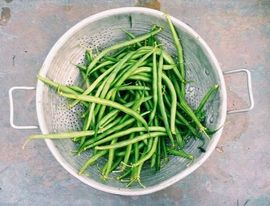
Despite all of the various fermented foods I have made over the past few years (kombucha being my most recent foray), one thing I had never tried fermenting for some reason is green beans. I've made many jars of very tasty vinegar "pickled" (technically marinated) green beans, but for some reason it never occurred to me to try fermenting them - until I ran across the recipe below on one of my favorite blogs.
Not only is this a very simple recipe, but it is absolutely delicious! I only wish I had discovered it sooner, as our summer of 10,000 green beans is finally coming to an end, so I only managed to make one small jar of these delightful pickles... :-( I will definitely be making lots more of these next year!
Lacto-Fermented Pickled Green Beans Recipe
Yield: 1 Quart
Ingredients:
- 1-2 cloves of garlic
- 2 heads fresh dill OR 1 tablespoon dill seed (we didn't grow dill this year, but I have a big bag of it in the freezer from last year, so I pulled out a few good-sized sprigs of the frozen stuff and used those.)
- 1 teaspoon black peppercorns
- 1 bay leaf
- 4 cups (about one pound) fresh green beans, washed with ends snapped off
- BRINE: 1 tablespoon kosher salt (or raw sea salt - I use this one) + 2 cups NON-CHLORINATED water (double or triple this as needed)
Instructions:
- Start with a clean quart-sized mason jar. Place the garlic, dill, peppercorns, and bay leaf in the bottom of the jar.
- Add the green beans to the jar-- I like to try to have them stand up on end, but if it doesn't work, just get them in there the best you can. Pack them as tightly as you can.
- Make your brine by stirring the salt into the water until it's completely dissolved. (If you're using unrefined sea salt, there may be some grit at the bottom that won't dissolve; make sure not to pour that in with your pickles or they may be gritty).
- Pour the brine over the top of the beans, making sure it covers the beans completely but leaves 1 to 2 inches of space at the top of the jar. You will need to weigh the beans down with something so they don't float to the top and poke out of the brine. I like using a glass fermenting weight for this, but you can use all sorts of things (jar lids, kitchen utensils, etc.)
- Screw the lid on fingertip-tight only. (Or use an air-lock lid like I do if you have one.)
- Place your jar of green beans on the counter away from other ferments (or any sourdough starter) that you might have going at the same time.
- Allow the beans to ferment for 5 to 7 days, checking the jar each day and "burping it" (opening the lid to release any gases) to avoid it spilling out of the jar (if you're not using an airlock). If you don't want to have to remember to burp it, you can use one of the many fermenting airlock systems available to streamline the process.
- Taste the beans at the end of the fermentation period to make sure you like how tangy they are. If you prefer bolder fermented beans, you can let them sit on the counter for a few more days, otherwise, pop them in the fridge and consume within two to three months.
My Notes:
1.) Unfortunately I didn't have enough beans for a full quart, so I made a pint-size batch using half the recipe above. I did use a whole clove of garlic since my husband and I both love things garlicky - plus we grow our own garlic, and we have plenty of it right now!
Fermentation recipes are very easy to adjust based on the quantity of ingredients you have available - just make sure to keep the salt-water ratio the same for the brine, no matter how much of it you make.
2.) As with all ferments, you MUST make sure your water does not contain chlorine, which will kill your beneficial bacteria and you'll end up with a smelly, slimy mess - NOT good. If your tap water is chlorinated, you have a few options:
- Use bottled or distilled water
- Use a good filter (like reverse-osmosis or similar) that removes chlorine
- De-chlorinate your own water by boiling it (uncovered) at a hard boil for several minutes, then letting cool completely (uncovered). We use this method, using tap water first filtered with a countertop filter.
3.) Firm, young, tender beans work best for these pickles. If they are over-mature, tough, woody, or spongy, they will not turn out as well. We grow a yellow bean called Gold Rush that is very slim and tender, and we liked these best in the pickles. The green ones we had were a bit tougher.
4.) If you don't like dill, or you want to add other spices, feel free! If you like spicy pickles, try adding some red pepper flakes or even a small, fresh red chili pepper. As I mentioned, ferments aren't picky. As long as you avoid chlorine and have the right salt-water ratio, it should work out just fine.
5.) If you end up with extra brine, don't throw it away! Just put it in a jar with a lid in the fridge - it will keep indefinitely, until you're ready to make another batch of pickles - which probably won't be long, once you taste these. :-)
6.) The time your pickles take to reach a good fermentation level will depend a lot on the temperature in your home. A moderate temperature of around 70-72 degrees is best. Slightly warmer will mean faster fermentation. Cooler will take longer. Ours took exactly 6 days on top of the fridge - where it averages around 73 degrees this time of year - and they turned out perfect! We are already halfway through our small jar in just 3 days, and I can't wait to make more next summer!
If you have fall green beans in your garden, definitely give these a try - and if not, make sure to bookmark or Pin this for next season!
Enjoy!
Rose.



 RSS Feed
RSS Feed